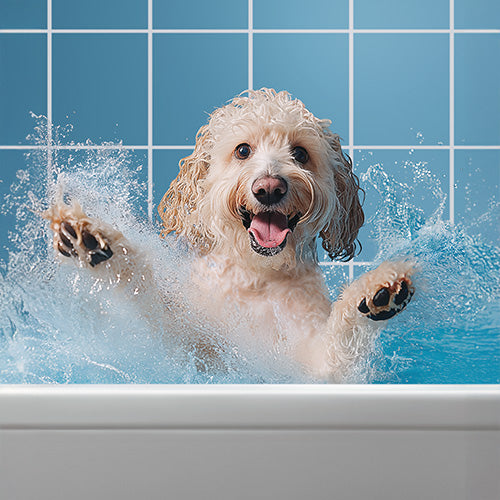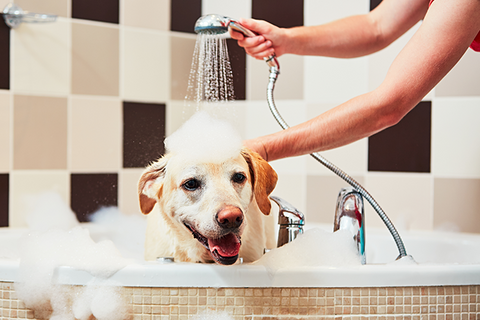
How can my cat be itchy and scratchy? He lives indoors!
Is your cat itching and scratching more than usual? You may be surprised to learn that even if your cat has no access to outdoors, they can still develop allergic skin disease. This article will discuss how and why this is possible and will cover the more common underlying causes of itchy skin.
How to spot if your cat is itchy
When cats become itchier, or pruritic, they over-groom and appear to constantly lick or pull their fur out, and because indoor cats usually spend more time with their humans, changes in their normal behaviour may be easier to pick up on. Excessive licking or scratching can be an obvious change, as they often differ from their normal grooming pattern. Other signs that your cat may have a skin or itchiness problem includes reddened skin, bald patches and skin sores or lesions. Behaviourally, your cat may seem more agitated and can even show signs of aggression
A fascinating condition is described in cats, where they have increased sensitivity in specific parts of their skin. Your cat’s skin may ‘twitch’ when stroked and they can react painfully to any kind of touch stimulus. The exact cause of this condition is unknown, but this condition is often seen in cats with allergic skin disease. This is known technically as Feline hyperaesthesia syndrome, and in a familiar way, ‘rolling cat syndrome,’
Causes of itchiness in indoor cats
Fleas and other parasites
Believe it or not, housecats can sometimes get fleas too, despite having no outdoor access, as the fleas hitch-hike in on other pets or even humans in the household. It is still recommended to use routine preventative flea and worm treatment in indoor cats! Fleas can lead to just infestation, or allergies. In fact, one of the most common types of allergies in cats is triggered by fleas, leading to a condition named ‘flea allergic dermatitis,’ also known as ‘FAD’. Cats with severe flea allergies can have a single reaction to only one flea bite, and this response is triggered by flea saliva. Cats with FAD often become intensely itchy and the skin along their backs can be extremely red, inflamed and sometimes even infected. Eradication of the flea problem should resolve the issue, but in the more severe cases treatment from your veterinarian to stop the itching is prescribed. Don’t forget the importance of environmental flea control and make sure that every pet in the household is treated!
Allergies
Indoor cats can develop allergies too! Besides the cutaneous manifestations, other signs of allergies in cats can also include coughing or sneezing.
Dust mites
Another common type of allergy seen in all cats, but in particular indoor cats is ‘house dust mite allergies.’ In felines affected by this condition, their itchiness is triggered by the house dust mite which live in every household. House dust mites live amongst bedding, carpets, and upholstery etc. For genetic reasons, some cats are progressively sensitised to their presence, and signs can include itchiness, hair loss, skin lesions and coughing/wheezing. Environmental management such as regular vacuuming, washing and household sprays are the mainstay of treating house dust mite allergies. Similar to FAD cases, your Vet may also need to prescribe anti-itch and anti-inflammatory medications. In many cases the treatment is short-term, but occasionally long-term treatment is prescribed in chronic cases.
Food allergies
Besides the well-known unexpected reaction to a new food, surprisingly, some cats that have been on the exact same food their entire life may still develop food allergies and intolerances. Food allergies may appear at any age. The foods typically associated with feline allergies include beef, fish, chicken, and dairy. As mentioned above, a food ingredient a cat has consumed their whole life can still lead to allergies later on in life. Signs of food allergies include year-round itching and skin inflammation but can less commonly include gastrointestinal symptoms such as vomiting or diarrhoea. If you suspect your cat may have a food allergy, your vet will work alongside you to formulate a suitable management plan, this may involve trialling a hypoallergenic dietary trial or an exclusion diet.
Contact allergies
Finally, contact allergies do exist in indoor cats but they are much rarer. In house cats, contact allergies can be associated with bedding, shampoos and washing detergents. Typically, the area of skin which comes into contact with the allergen becomes itchy and inflamed, causing your cat to obsessively scratch this area. Removal of the contact allergen often solves the problem; however, the primary source can often be really difficult to identify!
How can we help itchy cats?
DOUXO® S3 CALM is a useful product to use in itchy cats because it soothes irritated and sensitive skin. It aids in protecting the skin barrier against allergens such as house dust mites. DOUXO® S3 CALM can provide fast relief for your cat! This product comes in a variety of very useful forms including shampoo, leave-on mousse and pads, so you can choose which type of product your cat will like the best.
Feline allergies are extremely common and, unfortunately, they are seen in indoor cats too! If you do notice any changes in your cats grooming or general behaviour, please contact your veterinarian for advice.
We recommend DOUXO® S3 CALM
















